As expected, the Fed raised the Fed Funds rate by 75bps to 2.25%-2.50%. Yesterday’s FOMC statement makes it clear that taming inflation is trumping any fears they may have about slowing economic activity. The Fed’s statement alludes to softening economic growth indicators but they note the jobs market remains robust. The Fed has two congressionally mandates, prices and jobs. Given inflation rates remains at 40 year highs and unemployment rates are very low, we must assume a stall or pivot is not coming in the next few months. The exception to the forecast is financial instability or a much sharper decline in economic activity.
In Inflation or Recession, Wich Concern is Driving The Market, we show evidence that the market appears to be getting more comfortable with the Fed’s ability to fight inflation and less so with the growing odds of a recession. Today’s Fed meeting further supports the market view that fears of persistently high inflation trump concerns of economic weakness. In fact, Powell said on numerous occasions that a period of below-normal economic growth is necessary to get prices down.
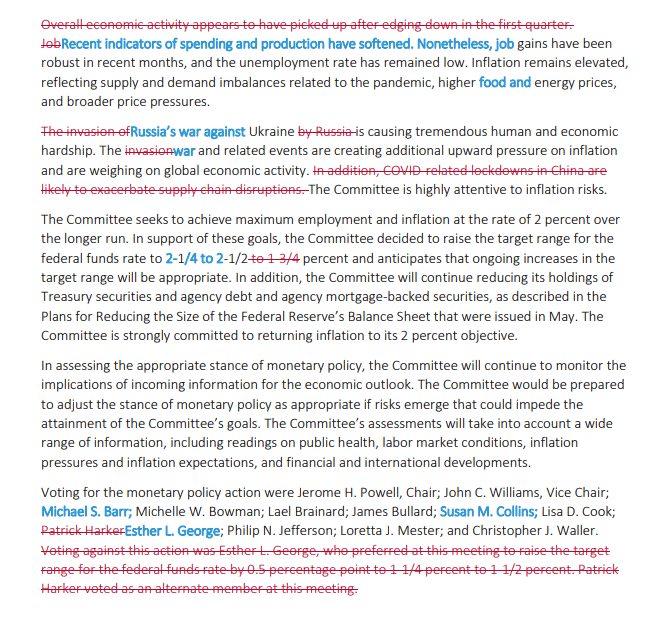

What To Watch Today
Economy
- 8:30 a.m. ET: GDP Annualized, quarterly rate, Q2 advance estimate (0.4% expected, -1.6% prior)
- 8:30 a.m. ET: Personal Consumption, quarterly rate, Q2 advance estimate (1.2% expected, 1.8% prior)
- 8:30 a.m. ET: GDP Price Index, quarterly rate, Q2 advance estimate (8.0% expected, -8.2% prior)
- 8:30 a.m. ET: Core PCE, quarterly rate, Q2 advance estimate (4.4% expected, 5.2% prior)
- 8:30 a.m. ET: Initial Jobless Claims, week ended July 23 (250,000 expected, 251,000 prior)
- 8:30 a.m. ET: Continuing Claims, week ended July 16 (1.386 million expected, 1.384 million prior)
- 11:00 a.m. ET: Kansas City Manufacturing Index, July (4 expected, 12 prior)
Earnings
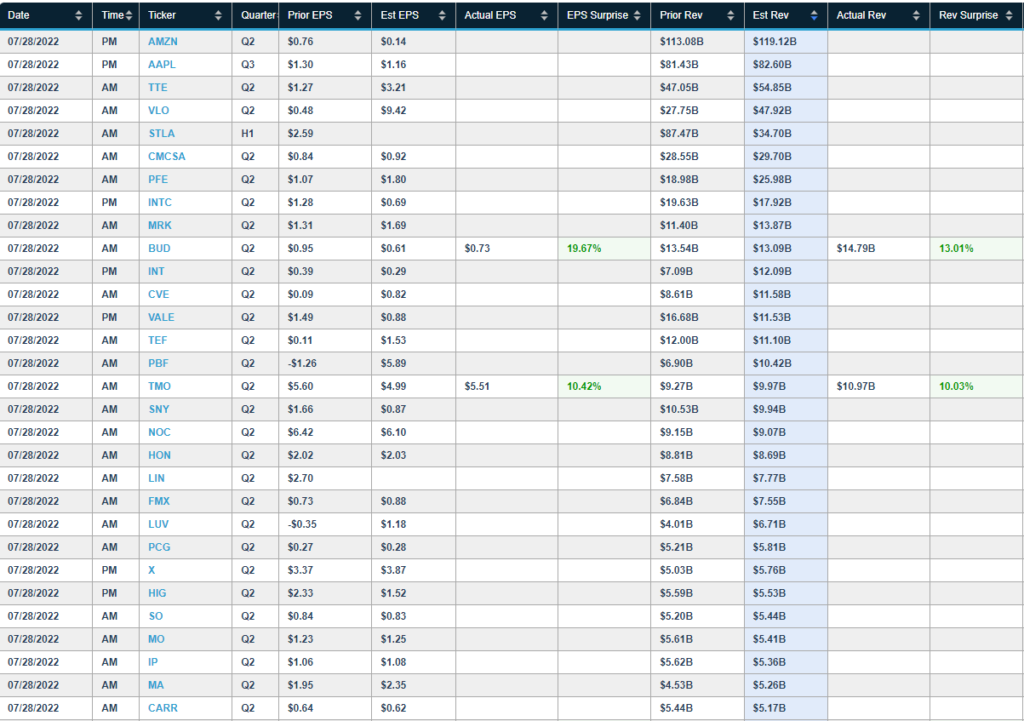
Market Makes Successful Retest Of Support And Breaks Higher
As noted yesterday, the market successfully tested and held the 50-dma. As the Fed maintained its stance, and despite inflation fears, the rally off that support broke above the recent highs, setting the market up for a bullish rally to 4100-4150ish. We are looking for any weakness in the next day or so to add some exposure to the growth side of our portfolio as the deflationary concerns are starting to support that trade. The market is overbought, so the upside is somewhat limited, but the earnings season continues to be supportive only by “not being as bad as expected.”
We still suspect there is risk in the intermediate term, so we continue to suggest managing risk accordingly.
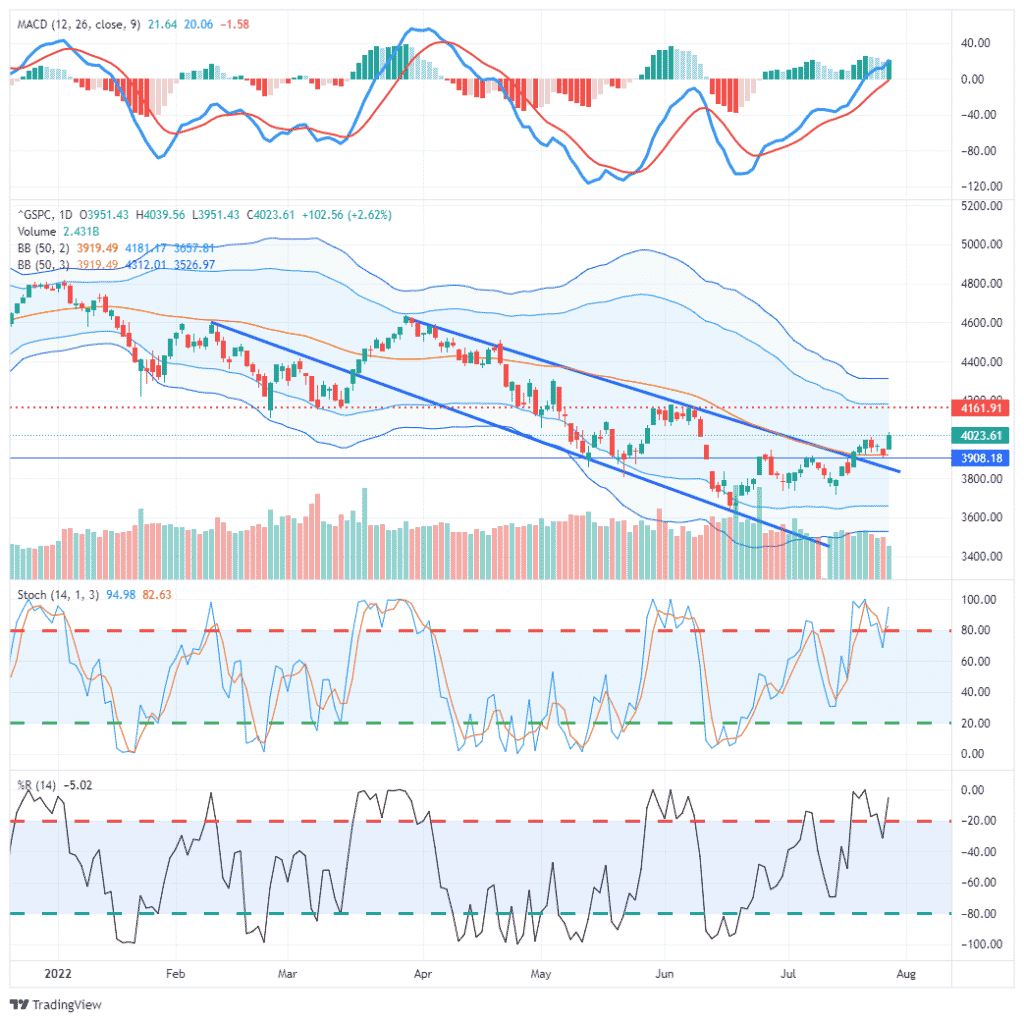
Stocks After A 4th Fed Rate Hike
When the Fed hiked rates for the first time, numerous articles discussed how stocks continued to rally historically speaking. While that hasn’t been the case this time, it does bring up the question of how stocks perform after the 4th rate hike.
“The 4th increase in the target rate preceded somewhat flat returns for the next few months and a negative outlook in the 6 & 12-month windows.
When the Federal Reserve increases the target rate for the 4th time, the unfriendly interest rate environment tends to weigh on stocks, especially in the 6 & 12-month time frame. A broad basket of commodities looks constructive, with a compelling record a year later. Copper, an industrial metal, performs well, and gold tends to underwhelm on a longer-term basis. When I apply the signals to the yield curve, one should not be surprised by an inversion in the 10-year to 3-month curve, especially given the recent drop and the negative 10-2 spread. Based on the Macro Index Model, the economy could deteriorate further.” – Sentiment Trader

The Deteriorating New Housing Market
Last week’s NAHB HomeBuilder Sentiment Index confirmed a sharp deterioration in the new home market. The west coast fared the worse, dropping from 89 to 48. All four regions of the nation saw moderate declines. The four critical takeaways from the report are as follows:
- Cancellations are rising quickly
- Price reductions are becoming commonplace
- Construction cost pressures are falling
- Builder layoffs are beginning to happen
New home construction accounts for almost 5% of GDP. As such, the state of new home construction has a meaningful impact on the economy and the labor market. The graph below shows that every time the trend in new homes for sale diverges with new homes sold, a recession started shortly after.
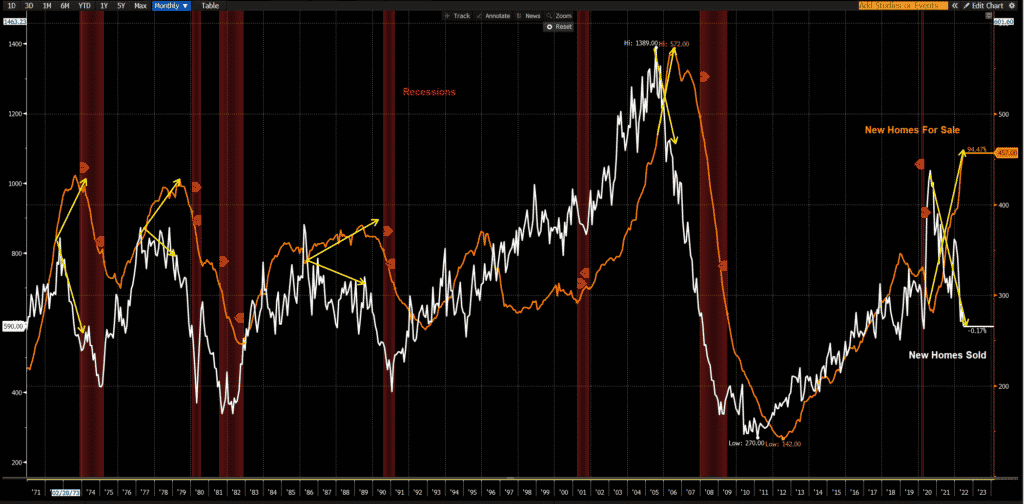
The graphs below show the surge in new house sales and the easing concerns over building material supply bottlenecks. Both graphs further confirm our thoughts that inflation pressures are falling.
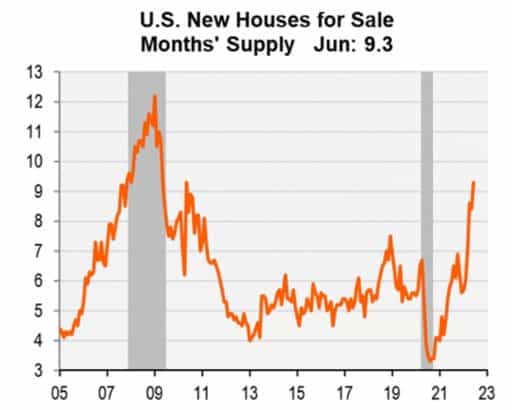
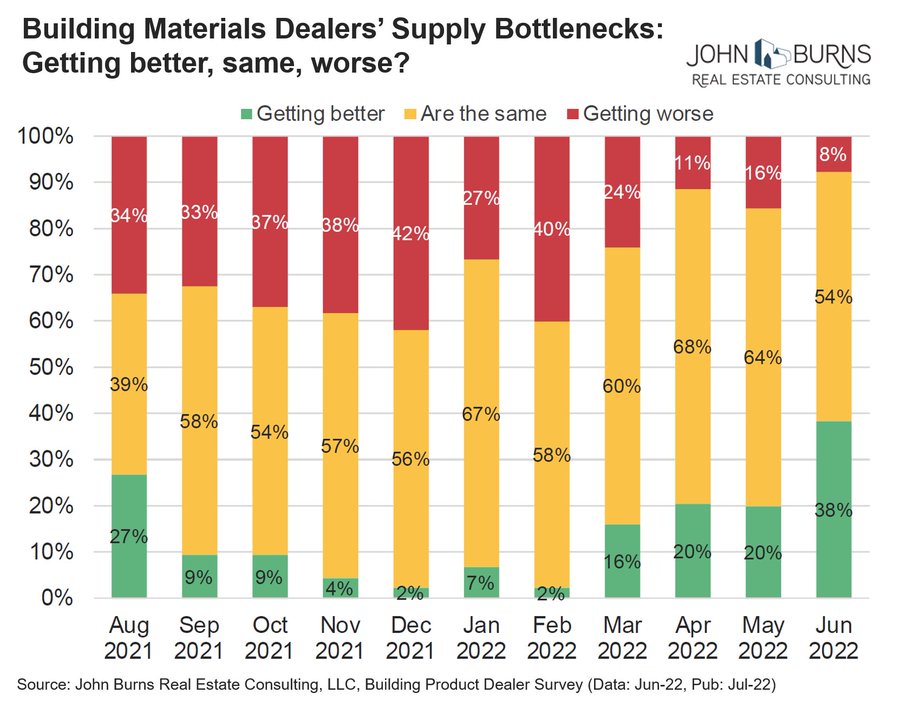
Are Homebuilder Stocks A Buy?
After reading the last section, you likely may answer the question with a resounding no. In Simplevisor, we provide subscribers with a weekly stock scan called Five for Friday. The report uses stock screeners to find five companies that best represent the theme of the scan. Last week’s report, for example, used a Goldman Sachs list of companies that are most and least vulnerable to a recession. We applied a value-based scan to 29 companies they deem least vulnerable list. Our report shared four companies that were least vulnerable to a downturn and are trading at low valuations. Interestingly two of the four were homebuilders. While NVR was not one of the four companies, it topped Goldman’s list of the least vulnerable companies.
Per our article:
For example, NVR is the least vulnerable stock on their list. Consensus EPS estimates forecast that NVR’s net profit margin will fall by 1.85%. Over the last three recessions, their net profit margin only fell by .42%. They also show that NVR’s expected profit margin is 39% below its 20-year average profit margin.
New home construction may face tough times, but some homebuilder stocks may already be priced appropriately for the bad news.
So Many People Hate Stocks – It’s Bullish
Investors have been downbeat about the prospects for stocks for months. What began as uncertainty led to pessimism and turned into outright disdain.
That sentiment started among the most speculative traders and bled into the sentiment among broader investors. Now, it has morphed into an almost apocalyptic sense of doom about the stock market among general U.S. consumers.
The latest survey of households by the Conference Board showed that only 25% of consumers expect stock prices to rise over the next twelve months. That reading is in the bottom 5% of all months since 1987. At the same time, a whopping 46% of consumers expect stocks to drop, ranking in the top 3% of all months since ’87.
The difference between bulls and bears has plunged to -21%, one of the worst readings in the survey’s history.” – Sentiment Trader
In other words, so many people hate stocks that it has historically been a bullish sign for the market.
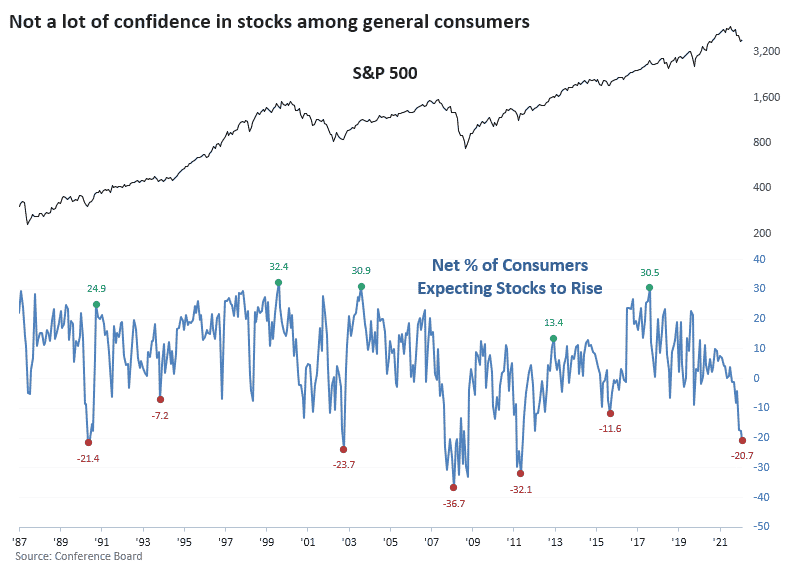
Global Inflation
The graph below from Apollo showing the number of countries reporting inflation at or below 2% is interesting for several reasons. First, it shows the global trend toward disinflation has been intact for almost 40 years. However, the trend at times is briefly interrupted by an outbreak of inflation rising over 2%. Excluding the recent covid-related recession, the prior four U.S. recessions saw inflation rising above 2% in every developed country. As we potentially approach another recession, there are zero countries with inflation rates below 2%. Making this instance unique is that inflation is much higher today than in the periods leading to the prior recessions. As such, central banks are struggling to determine whether they should fight their inflation fears or worry about the economy. The monetary policy prognosis for inflation is higher interest rates and QT. Conversely, the prognosis for a recession is lower interest rates and QE.
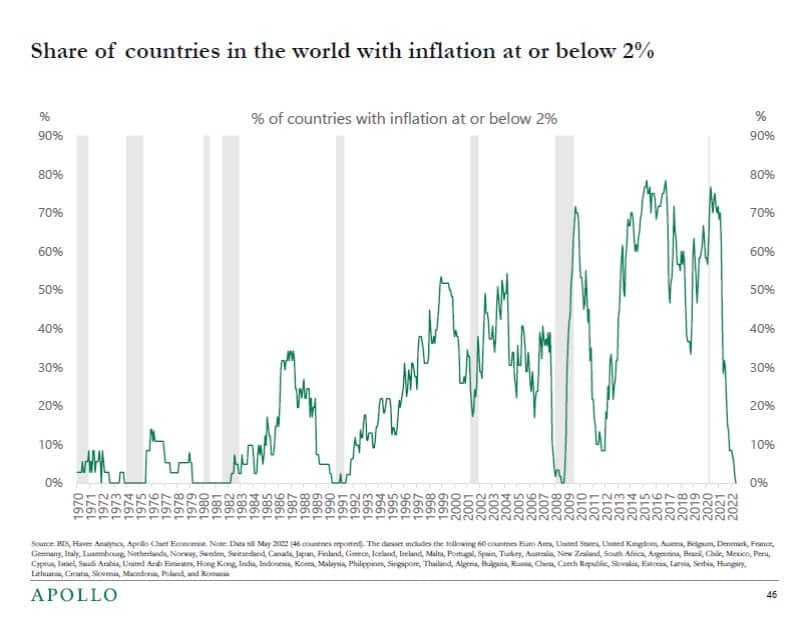
Please subscribe to the daily commentary to receive these updates every morning before the opening bell.
If you found this blog useful, please send it to someone else, share it on social media, or contact us to set up a meeting.




